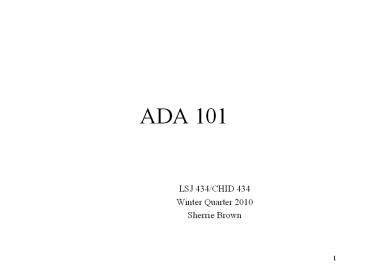ADA 101 - PowerPoint PPT Presentation
1 / 10
Title:
ADA 101
Description:
Title: REHABILITATION ACT OF 1973 Author: Kurt Johnson Last modified by: sbrown Created Date: 10/24/2003 8:05:19 PM Document presentation format: On-screen Show (4:3) – PowerPoint PPT presentation
Number of Views:135
Avg rating:3.0/5.0
Title: ADA 101
1
ADA 101
- LSJ 434/CHID 434
- Winter Quarter 2010
- Sherrie Brown
2
AMERICANS WITH DISABILITIES ACT (ADA) of 1990
- Comprehensive, broader coverage than
Rehabilitation Act of 1973 - Same definition for person with disability,
reasonable accommodation (modification), etc. - Covers
- Employers (Title I),
- Public Services of local and state government
(Title II), - Public Accommodations (Title III),
- Telecommunications Relay Services (Title IV).
- Defenses differ among titles generally undue
hardship, undue burden, direct threat,
unqualified. - Congress enacted amendments that were effective
1/1/2009 in response to Supreme Court decisions.
3
ADA Title I
- No covered entity shall discriminate against a
qualified individual with a disability because of
the disability of such individual in regard to
job application procedures, the hiring,
advancement or discharge of employees, employee
compensation, job training, and other terms,
conditions and privileges of employment. 42
U.S.C. 12112 (a) - No covered entity shall discriminate against a
qualified individual on the basis of disability
in regard to job application procedures, the
hiring, advancement, or discharge of employees,
employee compensation, job training, and other
terms, conditions, and privileges of employment.
42 U.S.C. 12112 (a) effective 1/2009
4
Qualified individual with a disability
- The term "qualified individual with a disability"
means an individual with a disability who, with
or without reasonable accommodation, can perform
the essential functions of the employment
position that such individual holds or desires. - For the purposes of this subchapter,
consideration shall be given to the employer's
judgment as to what functions of a job are
essential, and if an employer has prepared a
written description before advertising or
interviewing applicants for the job, this
description shall be considered evidence of the
essential functions of the job.
5
Terms of Art
- Person with disability is an individual
- With a Physical or Mental Impairment, that
Substantially Limits a Major Life Activity or - Has a history of such an impairment or
- Is regarded as having such an impairment.
6
Continued
- Qualified individual is one who
- Can perform the essential functions of the job
with or without reasonable accommodations or - Meets eligibility requirements for the program or
service in question.
7
Reasonable Accommodation/Modifications
- Modification or adjustments to the job or school
application process, work or school environment,
manner under which job or tasks are performed - Modification or adjustment that allows an
employee or student to enjoy same benefits and
privileges - Case by case analysis required
- Undue burden or substantial modification not
required
8
Discrimination
- What constitutes specific acts of
discrimination differs depending on the
situatione.g., discrimination in an employment
setting (Title I) is different that
discrimination in a school setting (Title II) or
in an access to public services case (Title III). - http//www.ada.gov/pubs/adastatute08mark.htm121
01note
9
Congress v. Supremes
- ADA Amendments of 2008
- Former President Bush signed the ADA Amendments
on September 25, 2008. - Act rejects some EEOC regulations and US Supreme
Court decisions that had changed previous
understandings of ADA definition of disability. - Effective January 1, 2009.
10
Summary
- ADA continues to use the earlier classic
statutory definition but changes the
judicial/regulatory interpretations - Mandates EEOC to revise regulations defining
substantially limits. - Expands the definition of major life activities
by including 2 non-excusive listsprevious EEOC
activities and major bodily functions. - Mitigating Measures other than ordinary
eyeglasses or contact lenses shall not be
considered when determining disability. - Impairment that is episodic or in remission is a
disability if it would substantially limit a
major life activity when active. - Individuals covered only under the regarded as
prong of the definition are not entitled to
reasonable accommodation. - Disability should be interpreted broadly.
- Prohibits discrimination on the basis of
disability in Title I.































